Analysis of Organophosphorus Pesticides by HPLC Using Magnetic SPE with Nitrogen-Doped Reduced Graphene Oxide/Fe3O4 Nanocomposite as the Adsorbent
LCGC North America
In this study, a method for extraction and preconcentration of trace amounts of organophosphorus pesticides was developed using magnetic solid-phase extraction followed by HPLC with UV detection
In this study, a method was developed for extraction and preconcentration of trace amounts of organophosphorus pesticides (OPPs), including fenitrothion, chlorpyrifos-methyl, and chlorpyrifos in environmental water. The method uses a new magnetic solid-phase extraction technique, followed by high performance liquid chromatography (HPLC) with ultraviolet (UV) detection. Nitrogen-doped reduced graphene oxide-iron oxide (Fe3O4) nanocomposite, used as the adsorbent of organophosphorus pesticides, was successfully prepared using an easy hydrolysis process. The nanocomposite was synthesized and characterized by X-ray photoelectron spectroscopy (XPS), Fourier transform infrared (FT-IR) spectroscopy, and X-ray diffraction (XRD). The effects of type and ratio of eluents, amount of the graphene oxide (GO)/Fe3O4 nanocomposite, pH, ionic strength, equilibrium time, and ultrasound time on the quantitative recoveries of fenitrothion, chlorpyrifos-methyl, and chlorpyrifos were investigated. On the basis of the best condition, the recoveries of the target analytes in real water samples were between 84.40% and 105.05%. The relative standard deviations varied from 1.21% to 4.22%. Finally, the method was successfully applied to the determination of three organophosphorus pesticides in real environmental water samples.
Organophosphorus pesticides (OPPs) have been widely used for preventing or decreasing damage caused by pests, weeds, and plant disease, and are very important for high-yield production in agriculture (1,2). However, as a result of extensive use, these OPPs enter the environmental water system by various sources, and, as a result, both human and animal populations are exposed to OPPs through drinking water. The most harmful outcome, however, may be the formation of mutagenic compounds during conventional oxidation processes (3). Therefore, it is necessary to develop an effective method for monitoring OPPs in real environmental water, which is useful for ensuring environmental and health safety.
The determination of OPPs has been carried out with a variety of techniques, such as gas chromatography with a flame photometric detector (GC-FPD) (4,5), liquid chromatography–mass spectrometry (LC-MS) (6), gas chromatography–mass spectrometry (GC-MS) (7), and gas chromatography with nitrogen–phosphorus detector (GC-NPD) (8). Even though most OPPs are analyzed by GC, high performance liquid chromatography (HPLC) is preferred to GC for analysis of OPPs because of the thermal lability of these compounds. In addition, HPLC is one of the most sensitive and selective analytical methods for the determination of organic pollutants in environmental water.
However, there are challenges in using HPLC for such analyses, because OPPs in environmental water samples, such as tap water, underground water, farmland water, lake water, and river water, are often present at low concentrations, and these matrices are considered to be very complex. Therefore, for HPLC analysis of OPPs in environmental water samples, an appropriate sample preparation technique is required to isolate and enrich the target analytes (9–11). To address this challenge, various sample preparation methods for analysis of OPPs have been researched, such as liquid–liquid extraction (LLE) (12), ultrasound-assisted dispersive liquid-liquid microextraction (UA-DLLME) (13), liquid–liquid microextraction based on solidification of floating organic droplets (DLLME-SFO) (14), and other traditional sample
pretreatment methods.
In recent years, there has been much interest in the study of the magnetic materials, such as iron oxide (Fe3O4) nanoparticles, which have been widely used for enrichment of organic pollutants in water, owing to various advantages, including their stability, good separation characteristics, availability, and avoidance of secondary contamination of samples (15–19). However, Fe3O4 nanoparticles, have a tendency to agglomerate into larger particles because of the magnetic tendencies of this compound (20–24). The most effective technique is to load Fe3O4 onto supporting materials, such as activated carbon or graphene. There are many researchers who load Fe3O4 onto graphene to analyze organic contaminants in water (21,25,26). However, in recent studies, the structure of the activated carbon was changed after treatment by strong oxidation (18,27). In another study, therefore, a new magnetic material, a nitrogen-doped reduced graphene oxide-Fe3O4 nanocomposite (N-RGO/Fe3O4), which was based on Fe3O4, was synthesized using an easy method. N-RGO/Fe3O4 has high adsorption capacity and strong catalytic ability for removing OPPs at low concentrations from environmental water, and the N-RGO incorporated with magnetic Fe3O4 nanoparticles is able to effectively overcome the challenge of the separation of adsorbent from aqueous solution (28).
However, N-RGO/Fe3O4 has long been used for electrochemical super capacitors and electrochemical catalysis (29–32). The aim of the present study, therefore, is to establish a new method of magnetic solid-phase extraction (MSPE) for enriching and separating OPPs in water samples. This is the first time that the novel N-RGO/Fe3O4 has been used as a solid-phase extraction agent for the enrichment of OPPs including fenitrothion, chlorpyrifos methyl, and chlorpyrifos in real water samples. This separation process can be performed directly in crude samples containing suspended solid materials without the need for filtration or additional centrifugation, which makes separation faster and easier. Furthermore, the recoveries of OPPs and reusability of the N-RGO/Fe3O4 were also evaluated. This method using sample pretreatment with magnetic SPE followed by HPLC analysis offers several advantages, including good precision and recoveries, low cost, and good reproducibility. Given these advantages, this new method may be broadly useful in many other fields.
Materials and Methods
Chemicals
Fenitrothion (purity >98%), chlorpyrifos methyl (purity >98%), chlorpyrifos (purity >98%), GO (purity >98%, layers <3), FeSO4·7H2O, NaCl, acetic acid, and NH3·H2O were obtained from Aladdin Ltd. The reagents used for the elution, including methanol, ethanol, acetone, acetonitrile, and ethyl acetate, were purchased from Taixin Ltd. Deionized water was provided using a laboratory system. All chemicals were used as received, without further purification. A stock solution containing fenitrothion, chlorpyrifos methyl, and chlorpyrifos at 100, 430, and 500 mg/L concentration, respectively, was prepared in methanol, and stored at 4 oC.
Instruments
An LC-20AT series HPLC system equipped with a solvent delivery pump, an SPD-20A UV-vis detector (Shimadzu), and an LC solution workstation were used for the analyses. An HY-5 mechanical shaker (Jintan Etong Electric Corp.) was used in this work. An SZ-2 system (Shanghai Lu West Analytical Instruments) was used to prepare double deionized water. A high-speed centrifuge was employed to centrifuge the sample solutions (Model 800).
Preparation of N-RGO/Fe3O4
The N-RGO was prepared by adding 260 mg graphene oxide (GO), 100 mL water, and 4 mL aqueous ammonia into a 250 mL round-bottom flask, and then heating at 180 °C for 24 h, followed by adding 5.2 mL of NH3·H2O with sonication for 7 min to thoroughly mix the solution. Finally, 8 mL of 0.35 g/mL freshly prepared FeSO4·7H2O was added to the solution, and heated in a water bath at 85 °C for 6 h to form N-RGO/Fe3O4. After being cooled to room temperature, negative-pressure filtration was used, and then N-RGO/Fe3O4 solids were washed with deionized water to neutralize them. Finally, N-RGO/Fe3O4 solids were placed in an oven to dry, and the dry solids were placed in storage for the next phase of the experiment.
HPLC Conditions
The HPLC separation was performed on a C18 column (150 mm × 4.6 mm, 5 µm, Beijing Jingkerida Technology Co., Ltd.) with equivalent elution using methanol and water at a rate of 1 mL/min and detection at 285 nm. The composition of equivalent elution was 85% methanol and water (0.1% acetic acid). The injection volume was 20 µL, and the column temperature was 35 oC.
Sample Preparation
We added 30 mg of N-RGO/Fe3O4 into 150 mL water to which was added 0.075 mL fenitrothion, 0.015 mL chlorpyrifos methyl, and 0.015ml chlorpyrifos, with a concentration of 5.0 mg/L for each analyte. The mixture was sonicated for 1 min to disperse the graphene, and then the conical flask was shaken on the platform of an orbital incubator for 30 min for adsorption equilibrium. Subsequently, an external magnet was placed on the bottom of the tube. After the solid phase was aggregated, the water phase was discarded. Simultaneously, the collected sorbents adsorbing the target analytes were eluted with 0.5 mL methanol and 0.5 mL ethyl acetate to desorb the analytes, which was sonicated for 5 min. Separation of solid and liquid phases was the same as above. The eluted solution was collected, then dried under a stream of nitrogen at 55 °C, and dissolved with 1 mL methanol. Finally, after filtration through 0.22 µm membrane, 20 μL of the solution was analyzed by HPLC.
Results and Discussion
Characterization of N-RGO/Fe3O4
In this study, the N-RGO/Fe3O4 was synthesized and characterized by Fourier transform infrared (FT-IR) spectroscopy, X-ray diffraction (XRD), and X-ray photoelectron spectroscopy (XPS).
FT-IR was used to identify the presence of functional groups and chemical bonds in material. Figure 1 shows the FT-IR spectra of N-RGO/Fe3O4 powders. The intense band at 592 cm−1 is assigned to the Fe-O bonds stretching of the magnetite, and the intense band at 3440 cm−1 is attributed to stretching of the amino group, which can provide the evidence to demonstrate that amino group were successfully grafted onto the surface of the RGO/Fe3O4 during preparation. The band at 1635 and 1128 cm−1 could be assigned to the aromatic skeleton C=C and C-C stretching vibration of the autoxidized graphitic domains and stretching vibrations of the epoxy, further confirming the above results.
Figure 1: FT-IR spectrum of N-RGO/Fe3O4.
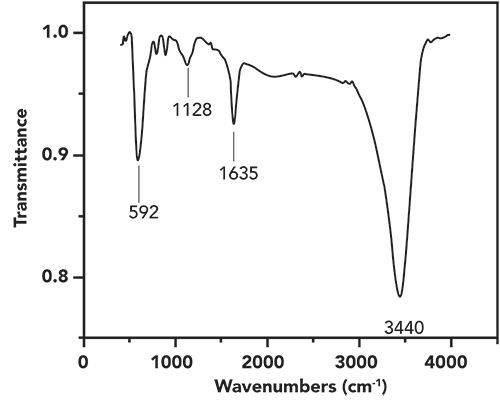
XRD is a common technology to determine the crystal structure of the superparamagnetic nanoparticles. The XRD pattern of the N-RGO/Fe3O4 is depicted in Figure 2. It shows diffraction peaks at 2θ = 18.10°, 30.13°, 35.69°, 36.36°, 43.04°, 53.51°, 57.07°, and 62.64°, which correspond to crystal indexes of (220), (311), (400), (222), (422), (511), and (440), respectively (JCPDS no. 19–0629) (30,33). For N-RGO/Fe3O4, the disappearance of the diffraction peaks corresponding to GO (24.6°) and N-RGO (43.1°) is attributed to inhibition of the restacking of graphene layers by the crystal growth of Fe3O4, leading to decreasing integrity of graphene oxide crystal structure (28).
Figure 2: XRD spectrum of N-RGO/Fe3O4.
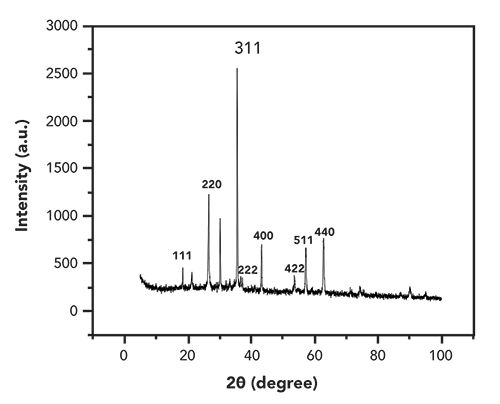
XPS was employed to further investigate the chemical composition of N-RGO/Fe3O4. As shown in Figure 3a, the XPS wide scan spectra of N-RGO/Fe3O4 clearly exhibited that the magnetic material mainly consisted of Fe, C, N, and O. Figure 3a also shows that the observation of Fe 2p3/2 and Fe 2p1/2 signals at 711 and 725â¯eV arose from the magnetic Fe3O4 core of prepared material, and from Figure 3a, and binding energy of N 1s was about 400â¯eV, which was attributed to the amino group. Thus, the presence of the peak for N 1s suggested the formation of amino group on surface of Fe3O4. Figures 3b and 3c show the high-resolution XPS of C 1s and O 1s. As can be seen from C 1s, the appearance of peaks at the binding energies of 284.7, 286.4, and 288.8â¯eV were corresponding to C-C in aromatic rings, C-OH, and C=O, respectively, which confirmed that RGO was successfully immobilized on N-Fe3O4 by acylation reaction. For O 1s, the typical peak at 530.3 and 531.8â¯eV were corresponding to O-H and C=O, respectively, which suggest there were different oxygen-containing groups. Thus, these indicated the successful preparation of N-RGO/Fe3O4.
Figure 3: (a)–(c) Representative XPS spectra of N-RGO/Fe3O4.

Optimized MSPE Procedures
In the present study, a 150 mL sample to which was added 0.075 mL fenitrothion, 0.015 mL chlorpyrifos methyl, and 0.015 mL chlorpyrifos for each analyte, was used to study the extraction performance of OPPs under different experimental conditions. During optimization, the experiments were analyzed them at least in duplicate.
Selection of Elution Solvents and Ratios
In this study, four elution solvents, including methanol, acetone, acetonitrile, and ethyl acetate, were used. Methanol has a better elution effect on chlorpyrifos and chlorpyrifos methyl than acetone, acetonitrile, or ethyl acetate. However, in addition to ethyl acetate, other elution solvents have little elution capacity for fenitrothion. This may be accounted for by their better solvation capabilities for the target analytes. Based on the above considerations, a mixed solvent of methanol and ethyl acetate was selected as the elution solvent.
The rate of the elution solvent was also an important factor affecting the extraction and recoveries efficiency. To achieve good extraction and recoveries for the target analytes, different ratios of methanol and ethyl acetate (for example, Vmethanol: Vethyl acetate=5:1; 3:1; 1:1; 1:3; and 1:5, respectively) were compared at these study. As shown in Figure 4a, the results showed that the extraction recovery of fenitrothion was affected by the ratio of methanol to ethyl acetate, and when the ratio of methanol and ethyl acetate was 1:1, the recoveries of fenitrothion and chlorpyrifos methyl were highest. However, the greatest recovery of chlorpyrifos appeared at 1:3. This may be owing to the strong polarity of ethyl acetate for chlorpyrifos. Considering that the change of extraction recovery of chlorpyrifos and chlorpyrifos methyl with the ratios of methanol and ethyl acetate is less obvious than fenitrothion, Vmethanol:Vethyl acetate=1:1 was selected as the optimum rate for the following experiments, at a total volume equal to 1 mL.
Figure 4: (a)–(f) Selection of different factors related to recovery and the elution solvent, solvent ratios, and sample treatment. Detailed explanations are found in the text. F is fenitrothion, C is chlorpyrifos, and C–M is chlorpyrifos methyl. Recovery of 1.0 is equivalent to 100%.

Selection of the Amount of N-RGO/Fe3O4
To improve the enrichment efficiency of the extraction method, the amount of N-RGO/Fe3O4 was investigated, from 10 to 50 mg. As shown in Figure 4b, when the amount of N-RGO/Fe3O4 added was 30 mg, the recovery reached peak; this result was a result of the stronger adsorption capability of the N-RGO/Fe3O4. The peak areas of the three tested analytes slightly decreased when the amount of N-RGO/Fe3O4 was increased from 30 to 50 mg. There is one reason which can explain this phenomenon: A very high amount of adsorbent requires high amounts of desorbing solvent to elute the analytes, so the peak areas of test analytes are reduced. Therefore, an optimal sorbent amount of 30 mg was selected for further experiments.
Selection of Sample Solution pH
To examine the effect of the sample solution pH, the pH was studied ranging from 3.0 to 11.0, which was adjusted by using CH3COOH and NH3·H2O solution. From the results, as shown in Figure 4c, it was found that the recoveries of OPPs increased when increasing the pH of the sample solution from 3.0 to 6.0. This is due to the electrostatic interactions that the three tested OPPs exhibit on the surface of the N-RGO/Fe3O4. At pHâ¯<6.0, both the analyte and the adsorbent surfaces are positively charged, and the electrostatic repulsion between two positive charges is a robust force. Further increases in solution pH were also examined, and it was found that the peak areas of the OPPs decreased when the pH was above 6.0. This result was attributed to the fact that more oxygen-containing groups on the N-RGO/Fe3O4 surfaces are ionized when the pH is above 6.0, which causes lower extraction of analyte materials. To sum up, a pH of 6.0 was selected for follow-up experiments.
Selection of Ionic Strength
To investigate the effect of ionic strength on the adsorption percentage of OPPs on N-RGO/Fe3O4, the ionic strength was set over the range of 0–11% (adding NaCl of 0, 4.5, 7.5, 11.5, and 14.5 g), and the results are shown in Figure 4d. As can be seen, the recoveries rose rapidly with the increasing NaCl concentration at the beginning, due to the salting out effect and the higher viscosity, which may make the process of extraction between the target analytes and adsorbents more effective. Meanwhile, previous studies suggested that an excessive amount of NaCl may reduce the extraction kinetics. Thus, the optimal salt addition was determined to be 5%.
Selection of Equilibrium Time
Adsorption equilibrium time is an important factor for evaluating the adsorption capacity of the materials, because MSPE is a partition equilibrium process of analytes between adsorbents materials and sample solution. To screen out the optimum conditions, the effect of extraction time from 10 to 50 min were explored. As shown in Figure 4e, the maximum recoveries were obtained when the extraction time was 30 min for the three analytes. Thus, 30 min was selected as optimum adsorption equilibrium time for the further experiments.
Selection of Ultrasound Time
Ultrasound time is the minimum time needed for quantitative desorption of the analytes, which is another essential factor that affects the recoveries of the analytes. As shown in Figure 4f, for screening out optimum ultrasound time, 3–11 min was set for experiments. For fenitrothion, 3 min was enough to get desorption, while 5 min was needed for chlorpyrifos and chlorpyrifos methyl. In terms of total recovery for the three OPPs, 5 min was selected as the optimal ultrasound time.
Validation of the HPLC Method
To validate the developed HPLC method for the analysis of OPPs, the linearity was evaluated using a series of standard mixture solutions of the analytes. Concentrations from 0.020 to 800 μg/mL were obtained for the establishment of the calibration curve. For each level, five repetitive measurements were carried out. Relative standard deviations (RSDs), enrichment factors (EFs), and limits of detection (LODs) were examined to evaluate the HPLC method.
The recovery percentage (RSD) was calculated by following equation 1 (34):
RSD = (C1-C2)/C1*100% [1]
where C1 and C2 are the final concentration of the analyte in the spiked sample and in the unspiked sample, respectively.
The enrichment factor was calculated with equation 2 (34):
EF = Ca/Co [2]
where Ca and Co are the final concentration of the analyte in the organic phase (extraction solvent) and the initial concentration of the analyte in the aqueous phase, respectively.
The results are shown in Table I. Three OPPs exhibited good linearity with correlation coefficients (R2) between 0.9993 and 0.9997, and the RSDs varied from 1.58% to 2.90%. The LODs of 0.04–0.06 μg/mL for the analytes were obtained based on the ratio of signal-to-noise (S/N = 3), with the RSDs (n = 5) lower than 3.58%. Finally, EFs were in the range of 133 to 166, which demonstrates that the HPLC method has high values and good extraction performance. Above all, it can be concluded that good sensitivity and reproducibility could be achieved with the developed HPLC method.
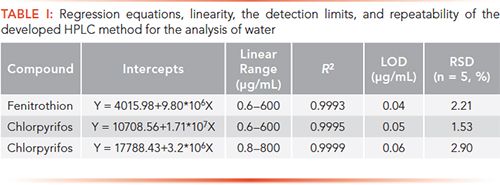
Application to Real Samples
The proposed N-RGO/Fe3O4 was applied to determine three OPPs, including fenitrothion, chlorpyrifos, and chlorpyrifos methyl residues in environmental samples under the above optimum conditions established. No OPPs were found in the real samples; the recovery was carried out by spiking known concentrations of mixed standard OPPs into the samples before added the N-RGO/Fe3O4. For each concentration level, three replicate experiments with the whole analysis process were performed. The results are listed in Table II, and the result shows that this method has good extraction efficiency for analyzing of three OPPs in real water samples. The recoveries of the studied OPPs were between 84.40% and 105.05%. Figure 5 shows the typical chromatograms of tap water and lake water.
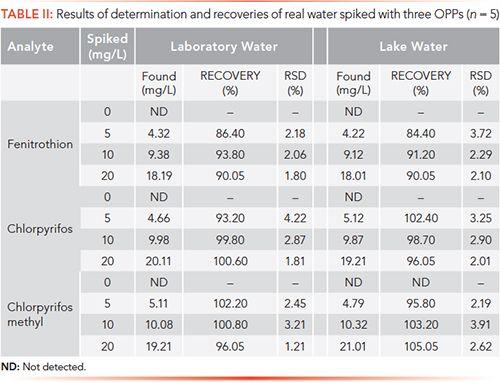
Figure 5: (a),(b) Replicate chromatograms of tap water and lake water.
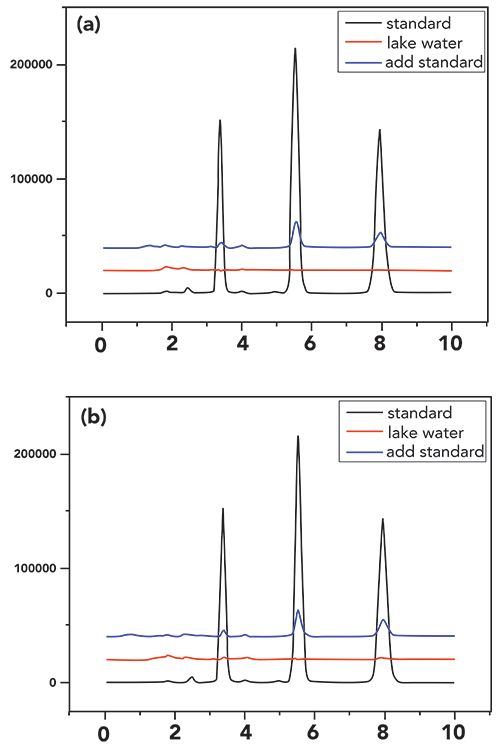
Conclusions
In this study, a method based on MSPE-HPLC with N-RGO/Fe3O4 as the adsorbent was proposed for analyzing of three organophosphorus pesticides, fenitrothion, chlorpyrifos, and chlorpyrifos methyl, in environmental water. A rapid separation of organophosphorus pesticides was achieved. The developed method provided fast analysis process, high EFs, low LODs, wide linear range, and good anti-interference ability. This method fully embodies the high speed and efficiency of HPLC. It is suitable for the speciation of OPPs in environmental studies.
Acknowledgments
We thank the Fundamental Research Funds for the Central Universities (XDJK2018C043).
References
- B. Jongenotter and H.G. Janssen, LCGC Europe 15, 338–357 (2002)..
- S. Hassani, S. Momtaz, F. Vakhshiteh, A.S. Maghsoudi, M.R. Ganjali, P. Norouzi, and M. Abdollahi, Aquat. Toxicol. 91, 109–130 (2017).
- M.I. Badawy, M.Y. Ghaly, and T.A. Gad-Allah, Desalination 194, 166–175 (2006).
- J. Chen, C. Duan, and Y. Guan, J. Chromatogr. B. 878, 1216–1225 (2010).
- E. Zhao, W. Zhao, L. Han, S. Jiang, and Z. Zhou, J. Chromatogr. A 1175, 137–140 (2007).
- H. Mol, R.V. Dam, and O.M. Steijger, J. Chromatogr. A 1015, 119–127 (2003).
- H. Chen, R. Chen, R. Feng, S. Li, Chromatographia 70, 165–172 (2009).
- F. Tian, W. Liu, H. Fang, M. An, and S. Duan, Chromatographia 77, 487–492 (2014).
- D. Harshit, K. Charmy, and P. Nrupesh, Food Chem. 230, 448–453 (2017).
- T. Yaseen, H. Pu, and D.W. Sun, Food. Addit. Contam. A 36, 762–778 (2019).
- F.K. Wan, S.A. Ong, L.N. Ho, Y.S. Wong, C.H. Voon, S.Y. Yusuf, N.A. Yusoff, and S.L. Lee, Environ. Sci. Pollut. Res. 23, 16716–16721 (2016).
- J. Hassan and M. Sarkouhi, Arab. J. Chem. 9(s1), S1–S940 (2016).
- J.C. Wei, J. Hu, J. Cao, J.B. Wan, C. He, Y.J. Hu, H. Hu, and P. Li, J. Agr. Food. C 64, 932 (2016).
- G. Peng, Q. He, Y. Lu, D. Mmereki, and Z. Zhong, Environ. Sci. Pollut. Res. Int. 23, 19409–19416 (2016).
- R. Nisticò, Res. Chem. Intermediat. 43, 1–39 (2017).
- C. Monteil, N. Bar, A. Bee, D. Villemin, and J. Beilstein, Nanotech. 7, 1447 (2016).
- R. Rameshbabu, N. Kumar, A. Karthigeyan, and B. Neppolian, Mater. Chem. Phys. 181, 106–115 (2016).
- J. Wang, S. Ji, R. Ma, Q. Wu, C. Wang, J. Qiang, and W. Zhi, Sep. Sci. Technol. 49, 861–867 (2014).
- M. Oyama and X. Chen, Anal. Sci. 30, 529–532 (2014).
- T.F. Marinca, B.V. Neamtu, I. Chicinas, and P.J. Pascuta, J. Therm. Anal. Calorim. 118(2), 1245–1251 (2014).
- N. Ferreirós, S. Labocha, J. El-Duweik, C. Schlecker, J. Lötsch, and G. Geisslinger, J. Sep. Sci. 37(5), 476–483 (2014).
- S.X. Gong, X.L. Wang, W. Liu, M.L. Wang, X. Wang, Z.W. Wang, and R.S. Zhao, J. Sep. Sci. 40, 1755–1764 (2017).
- Z. Li, S. Wu, C. Yang, Y. Ma, X. Fu, P. Ling, J. Guan, and Q. Kan, Mol. Catal. 432, 267–273 (2017).
- M.A. Yan-Hua, Y.U. Chen-Fei, and X.G. Chen, J. Sep. Sci. 30, 709–712 ( 2014).
- C. Xiaoji, S. Lingxiao, Y. Xuemin, Z. Feifei, C. Jiaoyu, and M. Weimin, Analyst 139, 1938–1944 (2014).
- J. Lu, C. Deng, X. Zhang, and P. Yang, Acs. App.l Mater. Inter. 5, 7330–7334 (2013).
- A. Bach and R. Semiat, Desalination 273, 57–63 (2011).
- G. Peng, M. Zhang, S. Deng, D. Shan, H. Qiang, and Y. Gang, Hem. Eng. J. 34, 361–370 (2018).
- Z.K. Ghouri, N.A.M.Barakat, A.M. Alam, M.S. Alsoufi, T.M. Bawazeer, A.F. Mohamed, and H.Y. Kim, Electrochimica Acta 184, 193–202 (2015).
- H.R. Naderi, P. Norouzi, M.R. Ganjali, and H. Gholipour-Ranjbar, Powder. Technol. 302, 298–308 (2016).
- H. Heydari and M.B. Gholivand, Appl. Phys. A. 123, 187–196 (2017).
- R. Zhou, Y. Zheng, D. Hulicovajurcakova, and S. Qiao, J. Mater. Chem. A 1, 13179–13185 (2013).
- B. Li, H. Cao, J. Shao, M. Qu, and J.H. Warner, J. Mater. Chem. A 21, 5069–5075 (2011).
- A.A. Nour, S. Hassan, and H. Akram, J. Chromatography B 1092, 480–488 (2018).
About the Column Editors
Yi Gao is with the Department of Analytical Chemistry in the Graduate School of Chemistry and Chemical Engineering, at Southwest University, in Chongqing, in The People’s Republic of China. Qingqing Pan is with the Department of Chemistry in the Graduate School of Chemistry and Chemical Engineering, at Southwest University, in Chongqing, in The People’s Republic of China. Direct correspondence to: hxraining@swu.edu.cn

Determining Enhanced Sensitivity to Odors due to Anxiety-Associated Chemosignals with GC
May 8th 2025Based on their hypothesis that smelling anxiety chemosignals can, like visual anxiety induction, lead to an increase in odor sensitivity, a joint study between the University of Erlangen-Nuremberg (Erlangen, Germany) and the Fraunhofer Institute for Process Engineering and Packaging (Freising, Germany) combined behavioral experiments, odor profile analysis by a trained panel, and instrumental analysis of odorants (gas chromatography-olfactometry) and volatiles (gas chromatography-mass spectrometry).
Investigating 3D-Printable Stationary Phases in Liquid Chromatography
May 7th 20253D printing technology has potential in chromatography, but a major challenge is developing materials with both high porosity and robust mechanical properties. Recently, scientists compared the separation performances of eight different 3D printable stationary phases.
Detecting Hyper-Fast Chromatographic Peaks Using Ion Mobility Spectrometry
May 6th 2025Ion mobility spectrometers can detect trace compounds quickly, though they can face various issues with detecting certain peaks. University of Hannover scientists created a new system for resolving hyper-fast gas chromatography (GC) peaks.

.png&w=3840&q=75)

.png&w=3840&q=75)



.png&w=3840&q=75)



.png&w=3840&q=75)










